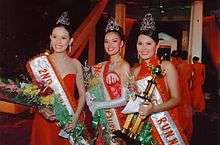MassKara Festival
| Masskara Festival | |
|---|---|
 | |
| Genre | carnival, parade, street dancing |
| Dates | third week of October |
| Location(s) | Bacolod City, Philippines |
| Years active | 1980 - present |
| Website | |
| Official website | |

The Masskara Festival (Hiligaynon: Pista sang MassKara, Filipino: Fiesta ng MassKara) is a festival held each year in Bacolod, Philippines, every third weekend of October nearest October 19, the city's Charter anniversary.
Etymology
The word "Masskara" is a portmanteau, coined by the late artist Ely Santiago from mass (a multitude of people), and the Spanish word cara (face), thus forming MassKara (a multitude of faces). The word is also a pun on maskara, Filipino for "mask" (itself from Spanish máscara), since a prominent feature of the festival are the masks worn by participants, which are always adorned with smiling faces.
History
The festival first began in 1980 during a period of crisis. The province relied on sugar cane as its primary agricultural crop, and the price of sugar was at an all-time low due to the introduction of sugar substitutes like high fructose (corn syrup) in the United States. This was the first Masskara Festival and a time of tragedy; on April 22 of that year, the inter-island vessel MV Don Juan carrying many Negrenses, including those belonging to prominent families in Bacolod City, collided with the tanker Tacloban City and sank. An estimated 700 lives were lost in the tragedy.
In the midst of these tragic events, the city's artists, local government and civic groups decided to hold a festival of smiles, because the city at that time was also known as the City of Smiles. They reasoned that a festival was also a good opportunity to pull the residents out of the pervasive gloomy atmosphere. The initial festival was therefore, a declaration by the people of the city that no matter how tough and bad the times were, Bacolod City is going to pull through, survive, and in the end, triumph.
Masks
The Masks in the history of the festival is constantly changing from masks influenced by native Filipinos which slowly was then influenced by Carnival of Venice and Rio Carnival motifs. Earlier Masks were hand-painted and adorned with feathers, flowers and native beads, while modern masks feature plastic beads and sequins.
Events
The festival features a street dance competition where people from all walks of life troop to the streets to see colorfully masked dancers gyrating to the rhythm of Latin musical beats in a display of mastery, gaiety, coordination and stamina. Major activities include the MassKara Queen beauty pageant, carnivals, drum and bugle corps competitions, food festivals, sports events, musical concerts, agriculture-trade fairs, garden shows, and other special events organized ad-hoc every year.
Street Dancing
The Street Dancing is divided into two categories; the schools division and the barangays, the latter is considered as the highlight of the street dancing competition.
Grand Champions
Barangay Category
| Year | Barangay |
| 2006 | Alijis |
| 2007 | Alijis |
| 2008 | Bata |
| 2009 | Taculing |
| 2010 | Mandalagan |
| 2011 | Banago |
| 2012 | 17 |
| 2013 | 16 |
| 2014 | Granada |
| 2015 | Granada |
| 2016 | TBA |
See also
References
External links
- MassKara Festival Page of the Bacolod City Official Website
- MassKara Festival Photo Gallery of the Bacolod City Official Website